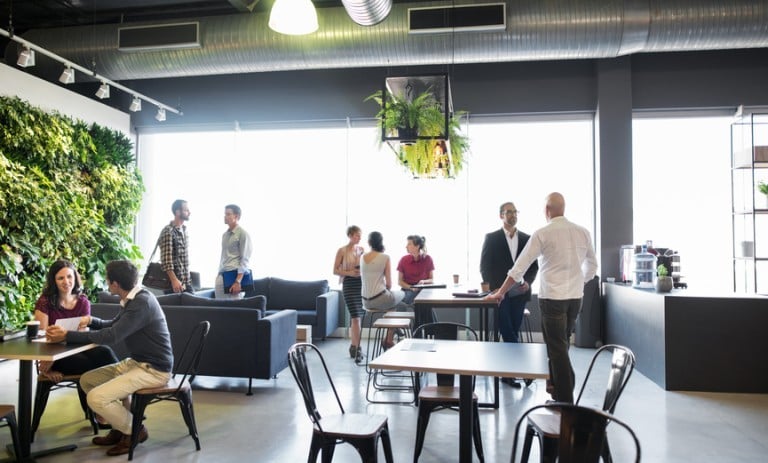Office Environment: Workplace Environment and Productivity
- Administración
- Artículo
-
Lectura de 6 minutos
-
Last Updated: 12/17/2021

Table of Contents
Successful business owners know that employees are their most valuable assets. Creativity, productivity, branding, marketing, customer relationships, and more — your employees keep these engines running and your business moving forward. Protecting employees' overall well-being is a good way to keep your business healthy and your employees happy and engaged. Were you aware the office environment can play an important role in employee well-being, and consequently, overall performance and happiness?
There are many easy-to-overlook elements that collectively establish more effective office environments. In this article, you'll learn the potential effects of non-physical and physical work environments on employee well-being, how workplace design can affect productivity, and how to improve your office work environment. Understanding these connections can empower you to make decisions that can improve the health and well-being of your valuable teams, and subsequently, the success of your business.
Effects of the Work Environment on Employee Well-Being
Often used interchangeably, "wellness" and "well-being" generally refers to the state of an individual's overall health along with lifestyle practices that allow them to thrive, not just survive. Wellness is more than having good biometrics (weight, blood sugar, cholesterol levels, etc.) or the absence of disease. Over the years, numerous studies have explored how the mind and body are connected in more ways than not. According to Dr. Bill Hettler, co-founder of the National Wellness Institute, there are six interconnected dimensions to wellness:
- Physical
- Emotional
- Social
- Occupational
- Spiritual
- Intellectual
When Americans are spending 90% of their time indoors and about one-third of their time working, you can quickly understand the impact and effects the office environment has on employees' well-being. For instance, social interaction and stress are two components affected by both the physical and non-physical aspects of the office environment. A physical office that does not balance employees' need for quiet places to concentrate can lead to employee dissatisfaction and increased stress. Additionally, a workplace culture that doesn't incorporate socialization can also lead to dissatisfaction. Indoor air pollution can cause employees to experience physical illness and lack of access to natural elements, like plants, can increase feelings of anxiety. Work environments and physical office spaces that don't account for the health of an employee can lead to negative effects on an employee's overall well-being, health insurance claims, and a higher turnover rate.
How Workplace Design Affects Productivity
We can all understand how lack of access to a quiet workspace can impact one's ability to focus on the task at hand. Yet there are many more elements that contribute to how workplace design affects productivity. The impact of office design on employee productivity presents itself in more indirect ways, often contributing to increased stress levels, a sense of malaise, and lack of motivation.
Dark or artificially lit workspaces can affect employees' mental health and subsequently affect their productivity. Lack of access to regular movement can also negatively impact a worker's ability to concentrate and think creatively. Even office color schemes, or lack thereof, are capable of influencing employees' moods. A well-designed office space makes it easier to complete required tasks, work collaboratively, be imaginative, and experience better health and well-being.
How To Improve Your Office Work Environment
There are steps you can take to design or improve your office work environment to foster productivity and provide a healthy space for workers to thrive. Some modifications are small, while others require more thoughtful planning and investment. Collectively, the following tactics can make a noticeable impact on employee wellness and the benefits that go with it.
Create a Comfortable Physical Work Environment of an Office
Office layout and working conditions are tied together. A comfortable, physical work environment allows employees to remain focused and engaged while in the office. Accomplishing this, however, requires balancing the human need for social interaction with spaces that encourage focus and concentration. Closed-in cubicle farm setups can risk making employees feel trapped, while completely open-floor concepts don't provide enough privacy for all employees. A hybrid office design with strategic groupings of desks and tables may allow employees to feel more comfortable in an office. Try breaking up expansive spaces with bookcases, throw rugs, plants, and shelves to add a level of privacy and avoid distracting disturbances. Furnishings that are comfortable and ergonomically correct will encourage workers to feel relaxed and focused in the short term while preventing chronic, repetitive use injuries in the long term.
Design Workplace Zones for Specific Tasks
Whether it's collaboration, thinking creatively, or working through a complex task, an effective office environment accommodates the various duties an employee may have throughout the day. Ideally, employees can choose a workspace that suits the task on hand — think in terms of a worker rotating organically between small private offices, cozy gatherings spots for casual brainstorming and conversation, formal meeting rooms, or even a little downtime, all within a single workday. These zones should be strategically designed to facilitate certain tasks. Private zones can provide space for work that requires high concentration and quiet, while informal meeting spaces (with good coffee!) are useful for team catch-ups or other meetings and a place to work around people.
Provide a Healthy Office Space and Work Environment
Office layout is only one dimension of a healthy work environment. The resources and benefits that you provide also play a role in promoting and encouraging employee health and well-being. As highlighted above, having the flexibility to choose an appropriate workspace can facilitate productivity. That flexibility also refers to having in-office and remote options as well as working flexible hours to promote a sustainable work-life balance. Health and wellness benefits such as in-office yoga or meditation class, a gym membership, wellness challenges, or fitness wearables all promote healthier lifestyles.
In-office social spaces, such as a break room or other non-work areas can be important in maintaining mental health and building collaborative team culture. Pay attention though! These spaces should be pleasant and inviting. Consider asking workers what kind of break room would help them relax and feel comfortable.
Allowing regular breaks throughout the day for employees to focus on personal aspects of their lives, such as taking a walk outside or making a phone call is another way to improve employee wellness. In addition to better health, being trusted to have these breaks can encourage long-term loyalty and engagement to your business.
Finally, staying on top of personal needs can help provide clarity and peace of mind that employees need to give their best effort.
Incorporate Nature in the Workplace
Humans have an inherent physical and mental need to connect with nature, a concept known as biophilia. Time spent among trees, water features, and natural environments has been shown to reduce blood pressure and anxiety. Studies have shown that even microbreaks with views of green spaces and natural environments have a restorative effect on the human brain. Some species of indoor plants have also been proven to help filter toxins out of indoor air. Incorporating nature in the office — plants, water features, rocks or other natural forms, and even large photographic murals of natural views — can help create a work environment where creativity, concentration, and better whole-body health can thrive.
Lighting is also important. Our brains respond to natural light. If your office space lacks access to a lot of windows, new technologies in lighting can mimic the natural cycle of daylight, with cooler tones in the morning and warmer tones in the afternoon. This can increase energy levels and even play a role in combating seasonal affective disorders (SAD).
Keep a Clean Office for Optimal Physical Working Conditions in the Workplace
Cleanliness and tidiness are other dimensions of the physical working conditions in the workplace. An office environment filled with clutter and tangles of visible wires can impact concentration as well as increase the likelihood of a physical injury. The pandemic has put a spotlight on the importance of practicing good hygiene with shared surfaces such as copiers, door handles, desktops, light switches, and drawer pulls. Hiring a cleaning staff plus encouraging regular cleaning by keeping supplies accessible can help reduce the transmission of bacteria and viruses.
Work-From-Home Office Space
COVID-19 rapidly expanded the number of employees who work from home. Many of the steps taken to design an effective business office environment can also be applied to the home office. Equipping employees with the right technology such as laptops or desktops can help remote employees remain productive. Offering employees a stipend to set up their home office with ergonomic furniture, good lighting, and even a food credit can establish a work-from-home office space that prioritizes wellness and healthy work habits. Creating a home office does not have to be synonymous with being alone. Creating opportunities for remote socialization and keeping your remote employees engaged in wellness programs can help their overall health and well-being.
Conclusion
No longer is it sufficient to simply provide space and a desk and expect employees to produce their best work. Taking the time to create an effective work environment and incorporate strategic design tactics that support your employee health and wellness can go a long way toward keeping your workforce happier, more productive, and engaged to the benefit of their lives and your business.
Tags







